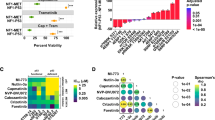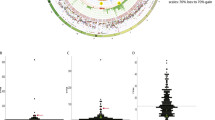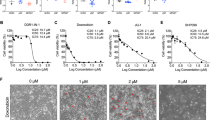Abstract
Mutations in the neurofibromatosis type 1 (NF1) tumor suppressor gene are common in cancer and can cause resistance to therapy. Using transcriptome analysis we identified MAF as an NF1- regulated transcription factor and verified MAF regulation through RAS/MAPK/AP-1 signaling in malignant peripheral nerve sheath tumor (MPNST) cell lines. MAF was also downregulated in human MPNST. Acute re-expression of MAF promoted expression of glial differentiation markers in MPNST cells in vitro, decreased self-renewal of embryonic precursors and transiently affected tumor cell phenotypes in vitro by increasing MPNST cell death and reducing metabolic activity and anchorage-independent growth. Paradoxically, chronic MAF overexpression enhanced MPNST cell tumor growth in vivo, correlating with elevated pS6 in vitro and in vivo. RAD001 blocked MAF-mediated tumor growth, and MAF regulated the mTOR pathway through DEPTOR. MAPK inhibition with NF1 loss of function is predicted to show limited efficacy due to reactivation of mTOR signaling via MAF.
This is a preview of subscription content, access via your institution
Access options
Subscribe to this journal
Receive 50 print issues and online access
$259.00 per year
only $5.18 per issue
Buy this article
- Purchase on SpringerLink
- Instant access to full article PDF
Prices may be subject to local taxes which are calculated during checkout









Similar content being viewed by others
References
Legius E, Marchuk DA, Collins FS, Glover TW . Somatic deletion of the neurofibromatosis type 1 gene in a neurofibrosarcoma supports a tumour suppressor gene hypothesis. Nat Genet 1993; 3: 122–126.
Brems H, Beert E, de Ravel T, Legius E . Mechanisms in the pathogenesis of malignant tumours in neurofibromatosis type 1. Lancet Oncol 2009; 10: 508–515.
Cancer Genome Atlas Research N, Comprehensive genomic characterization of squamous cell lung cancers. Nature 2012; 489: 519–525.
Ding L, Getz G, Wheeler DA, Mardis ER, McLellan MD, Cibulskis K et al. Somatic mutations affect key pathways in lung adenocarcinoma. Nature 2008; 455: 1069–1075.
Holzel M, Huang S, Koster J, Ora I, Lakeman A, Caron H et al. NF1 is a tumor suppressor in neuroblastoma that determines retinoic acid response and disease outcome. Cell 2010; 142: 218–229.
Verhaak RG, Hoadley KA, Purdom E, Wang V, Qi Y, Wilkerson MD et al. Integrated genomic analysis identifies clinically relevant subtypes of glioblastoma characterized by abnormalities in PDGFRA, IDH1, EGFR, and NF1. Cancer cell 2010; 17: 98–110.
Maertens O, Johnson B, Hollstein P, Frederick DT, Cooper ZA, Messiaen L et al. Elucidating distinct roles for NF1 in melanomagenesis. Cancer Discov 2013; 3: 338–349.
Whittaker SR, Theurillat JP, Van Allen E, Wagle N, Hsiao J, Cowley GS et al. A genome-scale RNA interference screen implicates NF1 loss in resistance to RAF inhibition. Cancer Discov 2013; 3: 350–362.
Donovan S, See W, Bonifas J, Stokoe D, Shannon KM . Hyperactivation of protein kinase B and ERK have discrete effects on survival, proliferation, and cytokine expression in Nf1-deficient myeloid cells. Cancer cell 2002; 2: 507–514.
Basu TN, Gutmann DH, Fletcher JA, Glover TW, Collins FS, Downward J . Aberrant regulation of ras proteins in malignant tumour cells from type 1 neurofibromatosis patients. Nature 1992; 356: 713–715.
DeClue JE, Papageorge AG, Fletcher JA, Diehl SR, Ratner N, Vass WC et al. Abnormal regulation of mammalian p21ras contributes to malignant tumor growth in von Recklinghausen (type 1) neurofibromatosis. Cell 1992; 69: 265–273.
Johannessen CM, Johnson BW, Williams SM, Chan AW, Reczek EE, Lynch RC et al. TORC1 is essential for NF1-associated malignancies. Curr Biol 2008; 18: 56–62.
Jessen WJ, Miller SJ, Jousma E, Wu J, Rizvi TA, Brundage ME et al. MEK inhibition exhibits efficacy in human and mouse neurofibromatosis tumors. J Clin Invest 2013; 123: 340–347.
Johansson G, Mahller YY, Collins MH, Kim MO, Nobukuni T, Perentesis J et al. Effective in vivo targeting of the mammalian target of rapamycin pathway in malignant peripheral nerve sheath tumors. Mol Cancer Ther 2008; 7: 1237–1245.
De Raedt T, Walton Z, Yecies JL, Li D, Chen Y, Malone CF et al. Exploiting cancer cell vulnerabilities to develop a combination therapy for ras-driven tumors. Cancer cell 2011; 20: 400–413.
Frank NY, Schatton T, Frank MH . The therapeutic promise of the cancer stem cell concept. J Clin Invest 2010; 120: 41–50.
Pardal R, Clarke MF, Morrison SJ . Applying the principles of stem-cell biology to cancer. Nat Rev Cancer 2003; 3: 895–902.
Buchstaller J, McKeever PE, Morrison SJ . Tumorigenic cells are common in mouse MPNSTs but their frequency depends upon tumor genotype and assay conditions. Cancer cell 2012; 21: 240–252.
Williams JP, Wu J, Johansson G, Rizvi TA, Miller SC, Geiger H et al. Nf1 mutation expands an EGFR-dependent peripheral nerve progenitor that confers neurofibroma tumorigenic potential. Cell stem cell 2008; 3: 658–669.
Keng VW, Rahrmann EP, Watson AL, Tschida BR, Moertel CL, Jessen WJ et al. PTEN and NF1 inactivation in Schwann cells produces a severe phenotype in the peripheral nervous system that promotes the development and malignant progression of peripheral nerve sheath tumors. Cancer Res 2012; 72: 3405–3413.
Wu J, Patmore DM, Jousma E, Eaves DW, Breving K, Patel AV et al. EGFR-STAT3 signaling promotes formation of malignant peripheral nerve sheath tumors. Oncogene 2013; 33: 173–180.
Pytel P, Karrison T, Can G, Tonsgard JH, Krausz T, Montag AG . Neoplasms with schwannian differentiation express transcription factors known to regulate normal schwann cell development. Int J Surg Pathol 2010; 18: 449–457.
Vogel KS, Klesse LJ, Velasco-Miguel S, Meyers K, Rushing EJ, Parada LF . Mouse tumor model for neurofibromatosis type 1. Science 1999; 286: 2176–2179.
Miller SJ, Jessen WJ, Mehta T, Hardiman A, Sites E, Kaiser S et al. Integrative genomic analyses of neurofibromatosis tumours identify SOX9 as a biomarker and survival gene. EMBO molecular medicine 2009; 1: 236–248.
Cheung M, Briscoe J . Neural crest development is regulated by the transcription factor Sox9. Development 2003; 130: 5681–5693.
Eychene A, Rocques N, Pouponnot C . A new MAFia in cancer. Nat Rev Cancer 2008; 8: 683–693.
Wende H, Lechner SG, Cheret C, Bourane S, Kolanczyk ME, Pattyn A et al. The transcription factor c-Maf controls touch receptor development and function. Science 2012; 335: 1373–1376.
Kerppola TK, Curran T . Maf and Nrl can bind to AP-1 sites and form heterodimers with Fos and Jun. Oncogene 1994; 9: 675–684.
Huang W, Lu N, Eberspaecher H, De Crombrugghe B . A new long form of c-Maf cooperates with Sox9 to activate the type II collagen gene. J Biol Chem 2002; 277: 50668–50675.
Pouponnot C, Sii-Felice K, Hmitou I, Rocques N, Lecoin L, Druillennec S et al. Cell context reveals a dual role for Maf in oncogenesis. Oncogene 2006; 25: 1299–1310.
Peterson TR, Laplante M, Thoreen CC, Sancak Y, Kang SA, Kuehl WM et al. DEPTOR is an mTOR inhibitor frequently overexpressed in multiple myeloma cells and required for their survival. Cell 2009; 137: 873–886.
Wang Z, Zhong J, Inuzuka H, Gao D, Shaik S, Sarkar FH et al. An evolving role for DEPTOR in tumor development and progression. Neoplasia 2012; 14: 368–375.
Miller SJ, Lan ZD, Hardiman A, Wu J, Kordich JJ, Patmore DM et al. Inhibition of Eyes Absent Homolog 4 expression induces malignant peripheral nerve sheath tumor necrosis. Oncogene 2010; 29: 368–379.
Karin M . The regulation of AP-1 activity by mitogen-activated protein kinases. J Biol Chem 1995; 270: 16483–16486.
Kraniak JM, Sun D, Mattingly RR, Reiners JJ Jr, Tainsky MA . The role of neurofibromin in N-Ras mediated AP-1 regulation in malignant peripheral nerve sheath tumors. Mol Cell Biochem 2010; 344: 267–276.
Olive M, Krylov D, Echlin DR, Gardner K, Taparowsky E, Vinson C . A dominant negative to activation protein-1 (AP1) that abolishes DNA binding and inhibits oncogenesis. J Biol Chem 1997; 272: 18586–18594.
Kataoka K, Handa H, Nishizawa M . Induction of cellular antioxidative stress genes through heterodimeric transcription factor Nrf2/small Maf by antirheumatic gold(I) compounds. J Biol Chem 2001; 276: 34074–34081.
Ho IC, Hodge MR, Rooney JW, Glimcher LH . The proto-oncogene c-maf is responsible for tissue-specific expression of interleukin-4. Cell 1996; 85: 973–983.
Mendoza MC, Er EE, Blenis J . The Ras-ERK and PI3K-mTOR pathways: cross-talk and compensation. Trends Biochem Sci 2011; 36: 320–328.
Annunziata CM, Hernandez L, Davis RE, Zingone A, Lamy L, Lam LT et al. A mechanistic rationale for MEK inhibitor therapy in myeloma based on blockade of MAF oncogene expression. Blood 2011; 117: 2396–2404.
Sun D, Haddad R, Kraniak JM, Horne SD, Tainsky MA . RAS/MEK-Independent Gene Expression Reveals BMP2-Related Malignant Phenotypes in the Nf1-Deficient MPNST. Mol Cancer Res 2013; 11: 616–627.
Watson JE, Doggett NA, Albertson DG, Andaya A, Chinnaiyan A, van Dekken H et al. Integration of high-resolution array comparative genomic hybridization analysis of chromosome 16q with expression array data refines common regions of loss at 16q23-qter and identifies underlying candidate tumor suppressor genes in prostate cancer. Oncogene 2004; 23: 3487–3494.
Endo M, Yamamoto H, Setsu N, Kohashi K, Takahashi Y, Ishii T et al. Prognostic significance of AKT/mTOR and MAPK pathways and antitumor effect of mTOR inhibitor in NF1-related and sporadic malignant peripheral nerve sheath tumors. Clin Cancer Res 2013; 19: 450–461.
Lau N, Feldkamp MM, Roncari L, Loehr AH, Shannon P, Gutmann DH et al. Loss of neurofibromin is associated with activation of RAS/MAPK and PI3-K/AKT signaling in a neurofibromatosis 1 astrocytoma. J Neuropathol Exp Neurol 2000; 59: 759–767.
Zou CY, Smith KD, Zhu QS, Liu J, McCutcheon IE, Slopis JM et al. Dual targeting of AKT and mammalian target of rapamycin: a potential therapeutic approach for malignant peripheral nerve sheath tumor. Mol Cancer Ther 2009; 8: 1157–1168.
Zhao Y, Xiong X, Sun Y . DEPTOR an mTOR inhibitor, is a physiological substrate of SCF(betaTrCP) E3 ubiquitin ligase and regulates survival and autophagy. Mol Cell 2011; 44: 304–316.
Carracedo A, Ma L, Teruya-Feldstein J, Rojo F, Salmena L, Alimonti A et al. Inhibition of mTORC1 leads to MAPK pathway activation through a PI3K-dependent feedback loop in human cancer. J Clin Invest 2008; 118: 3065–3074.
Yin B, Morgan K, Hasz DE, Mao Z, Largaespada DA . Nfl gene inactivation in acute myeloid leukemia cells confers cytarabine resistance through MAPK and mTOR pathways. Leukemia 2006; 20: 151–154.
Stowe IB, Mercado EL, Stowe TR, Bell EL, Oses-Prieto JA, Hernandez H et al. A shared molecular mechanism underlies the human rasopathies Legius syndrome and Neurofibromatosis-1. Genes Dev 2012; 26: 1421–1426.
Acknowledgements
We thank Frank McCormick (UCSF) for providing NF1 constructs and Kohsuke Kataoka for providing the MAF reporter. We thank the Viral Vector Core in the Translational Core Laboratories at Cincinnati Children’s Hospital Medical Center for viral vector production. We thank Monica DeLay for assistance with flow cytometry from the Research Flow Cytometry Core in the Division of Rheumatology at Cincinnati Children’s Hospital Medical Center, supported in part by NIH AR-47363, NIH DK78392 and NIH DK90971. This work was supported by R01 NS28840 (to NR) and NIH-P50-NS057531 (to NR and TPC). MB was partially supported by a training grant, T32HD07463.
Author information
Authors and Affiliations
Corresponding author
Ethics declarations
Competing interests
The authors declare no conflict of interest.
Rights and permissions
About this article
Cite this article
Brundage, M., Tandon, P., Eaves, D. et al. MAF mediates crosstalk between Ras-MAPK and mTOR signaling in NF1. Oncogene 33, 5626–5636 (2014). https://doi.org/10.1038/onc.2013.506
Received:
Revised:
Accepted:
Published:
Issue date:
DOI: https://doi.org/10.1038/onc.2013.506
Keywords
This article is cited by
-
Integrative analysis reveals early epigenetic alterations in high-grade serous ovarian carcinomas
Experimental & Molecular Medicine (2023)
-
Establishment and genomic characterization of a sporadic malignant peripheral nerve sheath tumor cell line
Scientific Reports (2021)
-
MicroRNA-155 contributes to plexiform neurofibroma growth downstream of MEK
Oncogene (2021)
-
Monitoring therapy responses at the leukemic subclone level by ultra-deep amplicon resequencing in acute myeloid leukemia
Leukemia (2017)
-
The renewed battle against RAS-mutant cancers
Cellular and Molecular Life Sciences (2016)



